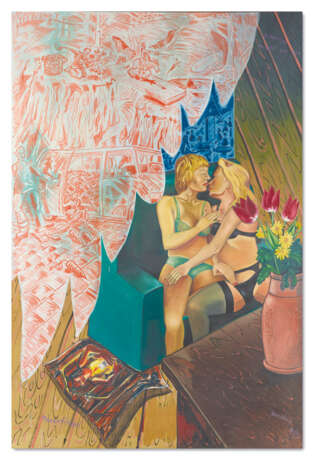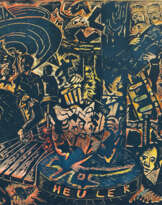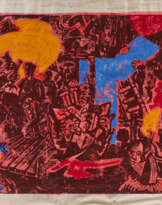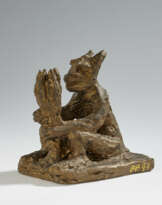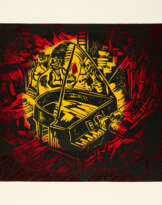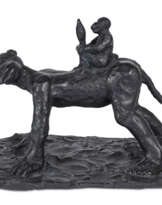ID 832049
Lot 35 | Jörg Immendorff (1945-2007)
Estimate value
€ 120 000 – 180 000
Manzonihügel (Manzoni Hill)
signé et daté 'Immendorff 91/92' (en bas à droite); inscrit 'Manzonihügel' (en bas à gauche); inscrit 'Manzoni hill Schwinge mischt sich ein' (en haut à droite)
huile sur toile
270 x 180 cm.
Peint en 1991-92
signed and dated 'Immendorff 91/92' (lower right); inscribed 'Manzonihügel' (lower left) and inscribed 'Manzoni hill Schwinge mischt sich ein' (upper right)
oil on canvas
106 1/4 x 70 7/8 in.
Painted in 1991-92
Provenance
L'artiste.
Succession de l'artiste.
Collection particulière, Allemagne.
Literature
HP. Riegel, Immendorff: die Biographie, Berlin, 2010, p. 219.
S. Gohr, Jörg Immendorff, Catalogue raisonné, paintings, vol. II, 1984-1998, Cologne, 2018, no. 290 (illustré en couleurs, p. 259).
Exhibited
Den Haag, Haags Gemeentmuseum et Rotterdam, Museum Boymans-van Beuningen, Immendorff, mai-août 1992, p. 225 (illustré, p. 106).
Paris, Centre Georges Pompidou, Musée National d'Art Moderne, Immendorff : Galeries contemporaines, mars-avril 1993.
Paris, Galerie Daniel Templon, 40 ans, Galerie Daniel Templon, Paris, 2006 (illustré en couleurs, p. 426; une vue de l'exposition illustrée en couleurs, p. 428).
Special notice
Artist's Resale Right ("droit de Suite").
If the Artist's Resale Right Regulations 2006 apply to this lot, the buyer also agrees to pay us an amount equal to the resale royalty provided for in those Regulations, and we undertake to the buyer to pay such amount to the artist's collection agent.
This item will be transferred to an offsite warehouse after the sale. Please refer to department for information about storage charges and collection
details.
Post lot text
Les œuvres de Jörg Immendorff, peintre allemand mondialement connu, sont souvent un hommage à des héros de l’histoire de l’art auxquels il s’identifie, notamment des artistes porteurs d’un message politique subversif. Le tableau intitulé « Manzonihügel » fait allusion à « Merda d’Artista », l’œuvre légendaire de l’artiste conceptuel italien Piero Manzoni (1933 - 1963). Merda d'Artista est une œuvre de 1961 pour laquelle l’artiste a décidé d’enfermer 30 grammes de ses excréments dans des boîtes de conserve, pour les vendre ensuite au poids selon le cours de l’or.
Il existe deux autres variations datant de la même époque, « Manzonivase I » et « Manzonivase II ». Mais « Manzonihügel » est la plus lyrique, la plus tendre des trois versions. Au centre, un couple de lesbiennes en lingerie, qui se désirent mutuellement, est assis dans un fauteuil vert. Comme souvent, Immendorff fait également référence à sa propre œuvre à travers de nombreux motifs. Ainsi, sous le fauteuil se trouve une sérigraphie légèrement froissée de son tableau « Malerwald ». On reconnaît l’artiste, portant une bougie et entouré de troncs d’arbres. Au premier plan, à gauche, le titre « Manzonihügel » (Colline de Manzoni) est écrit en fines lettres de couleur mauve. Le sol en planches sur lequel se déroule la scène fait référence aux décors d’Immendorff. Il a notamment réalisé les décors et les costumes de l’opéra d’Igor Stravinski « The Rake’s Progress », à l’occasion du festival de Salzbourg.
Sur la table en bois qui semble jaillir du tableau sur la droite, est posé le vase de Manzoni, déjà présent dans les deux autres variations. Il est rempli de tulipes rouges et de pissenlits jaunes, et décoré de silhouettes de singes qui font référence à l’alter ego d’Immendorff, le « singe-peintre », qu’il représentait souvent aussi sous forme de sculptures en bronze. Le choix des tulipes et des pissenlits est également symbolique : la tulipe représente l’amour profond, tandis que le pissenlit est censé symboliser la force vitale. Dans l’œuvre « Manzonihügel », contrairement aux autres versions, la « Merda » n’est plus visible que sous la forme d’un minuscule tas spiralé dessiné avec soin en haut à droite, sur l’aile de l’aigle. Au-dessus, le mot « Manzoni Hill » apparaît dans une bulle de bande dessinée.
Sur l’aile monumentale de l’aigle, évoquant un rideau de scène, se déroulent différentes scènes qu’Immendorff dessine en rouge avec des accents turquoises, à la manière d’un graffiti. L’aigle, tout comme l’abeille, est également l’un des motifs qui reviennent régulièrement chez Immendorff. L’artiste se représente trois fois sur l’aile de l’aigle. Au premier plan, il ouvre un chariot d’où se déversent des carottes, légumes censés favoriser la virilité. En haut à gauche, il arrache des pommes de terre qu’il jette dans un panier. À droite, il apparaît assis sur un âne, et laisse pendre une carotte au bout d’un bâton, à la manière d’une baguette de sourcier. En haut à droite, sur la face externe de l’aile, on peut lire la phrase : « Schwinge mischt sich ein » (L’aile s’immisce), une référence à l’aigle allemand, emblème national de la République fédérale d’Allemagne. Sous l’aile, enfin, on reconnaît dans le fragment de tableau bleu un extrait de l’œuvre « Café de Flore ».
Le grand nombre de références entremêlées, les symboles complexes et les insertions d’autres œuvres de l’artiste font de la toile « Manzonihügel » un chef-d’œuvre exceptionnel de ces années-là, peint avec brio. L’artiste entrelace ici l’histoire contemporaine et les récits autobiographiques, le passé et le présent, pour créer une scène de boudoir érotique et intime qui peut également être lue comme un hommage à la féminité. Aujourd’hui plus que jamais, l’œuvre de Jörg Immendorff est en phase avec l’actualité.
The works of the world-famous German painter Jörg Immendorff frequently pay homage to heroes of art history with whom he identifies, particularly those artists with a politically subversive message. The painting Manzonihügel alludes to the legendary work Merda d’Artista [Artists Shit] by the Italian conceptual artist Piero Manzoni (1933 – 1963). In 1961, Merda d’Artista was an event for which the artist had 30 grams of his excrement sealed in tin cans, each to be sold at the gold price of the same weight.
There are two other variations from the same period: Manzonivase I and Manzonivase II. Manzonihügel, however, is the most lyrical, the most tender of the three versions. In the centre, a lesbian couple wearing lingerie, desiring each other, sit in a green armchair. As is often the case, Immendorff also refers to his own works by means of numerous themes and references. Under the armchair, for example, there lies a slightly crumpled print-out of his work Malerwald [Painter’s wood]. We can see the artist carrying a candle, surrounded by tree trunks. On the front left, the title Manzonihügel can be seen in thin lilac letters. The wooden floorboards on which the scene takes place refer to Immendorff’s stage sets. Among other projects, he produced the stage sets and costumes for Igor Stravinsky’s opera The Rake’s Progress at the Salzburg Festival.
On the wooden table, which juts into the right front edge of the picture, stands one of the well-known Manzonivase variations with red tulips and yellow dandelions. The vessel is decorated with monkey silhouettes that refer to Immendorff’s alter ego, the “Maleraffen” or “painter monkey”, which he also frequently depicted as bronze sculptures. The choice of tulips and dandelions is also symbolic: tulips stand for deep love, and dandelions symbolise vitality. In contrast to the parallel versions, the merda in Manzonihügel is only visible as a tiny, carefully turned heap at the top right on the eagle’s wing. The words “Manzoni Hill” can be read above it as a comic bubble.
On the monumental eagle’s wing, which looks like a stage curtain, various scenes take place, which Immendorff has drawn graffiti-like in red with turquoise highlights. The eagle, like the bee, is also one of Immendorff’s emblems that appear time and again. He has immortalised himself three times on the eagle’s wing. At the front he opens a cart from which tumble carrots, supposedly potency-enhancing natural products. At the top left he pulls potatoes out of the ground and throws them into a basket. To the right he rides on a donkey and is holding a carrot dangling on a stick which is akin to a divining rod. At the top right, beyond the wing, is the sentence “Schwinge mischt sich ein” [The wing is interfering], a reference to the German eagle, the national emblem of the Federal Republic of Germany. Finally, the blue fragment of the painting under the wing at the upper right section shows a detail from the work Café de Flore.
The numerous, interwoven references and the multi-layered symbols and quotations from Immendorff’s own works make Manzonihügel an outstanding, brilliantly painted masterpiece from those years. Here, the artist weaves contemporary history and autobiographical stories, past and present, into an erotically intimate boudoir scene that can also be read as a homage to femininity. Today more than ever before, Jörg Immendorff’s work strikes a chord with the times.
| Artist: | Jörg Immendorff (1945 - 2007) |
|---|---|
| Art style: | Contemporary art |
| Place of origin: | Western Europe, Germany, Europe |
| Auction house category: | Paintings |
| Artist: | Jörg Immendorff (1945 - 2007) |
|---|---|
| Art style: | Contemporary art |
| Place of origin: | Western Europe, Germany, Europe |
| Auction house category: | Paintings |
| Address of auction |
CHRISTIE'S 8 King Street, St. James's SW1Y 6QT London United Kingdom | |
|---|---|---|
| Preview |
| |
| Phone | +44 (0)20 7839 9060 | |
| Buyer Premium | see on Website | |
| Conditions of purchase | Conditions of purchase |
